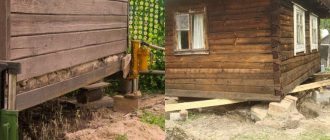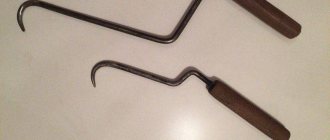Owners of country houses often need to carry out work related to the repair of the lower sections of the facade or foundation. For these purposes, you need to lift the entire building or a separate part of it; a special jack can help with this.
Such activities should be carried out with extreme caution; this article discusses suitable types of devices, as well as possible methods of raising the building.
What houses can be raised and why do it?
A feature of the operation of any wooden building is the need to replace the lower crowns. After some time, they simply fail due to rotting. Also, information on how to raise a house with your own hands using a jack will be useful to those who are planning to repair the foundation.
For major repairs, only one-story buildings made of timber or rounded logs, as well as panel buildings, can be lifted with a jack.
Correct and timely repairs are very important, because a building made of hard wood, such as oak or larch, can last up to a hundred years. Even now, wooden houses from pre-revolutionary buildings have been preserved. However, to achieve this longevity, the lower crowns need to be replaced approximately every 15-20 years.
A wooden house with timely repairs can last a very long time Source i.pinimg.com
Modern wooden buildings are not so durable, because due to environmental deterioration, timber is now more susceptible to rotting.
Precautions when lifting wooden houses
Lifting a house is not only difficult, but also quite a dangerous process, therefore, if you decide to carry out such work yourself, you should first familiarize yourself with the following precautions:
- At the preparatory stage, the house is strengthened in all directions. Logs can be fastened together using boards, and protection of window and door openings from distortions is provided using spacer beams.
- To place the jack, a special recess is first prepared at the angle of the structure.
- Installation of the jack is allowed only on a sufficiently strong and wide surface; usually boards are placed for this purpose.
- Lifting is necessarily preceded by studying the logs of the lower crown and checking their strength. Rotten areas must be strengthened; for these purposes, metal beams can be installed.
- Damage to the lower rims can be avoided by placing a metal plate under the retractable rod. It should have a slight unevenness where it stops.
External signs of problems
There are several signs that indicate it is time to repair the lower part of the building. It's easy to spot them. This may include:
- Violation of the foundation of the house
- Deepening the foundation into the ground
- Subsidence of the building in the corners
- Severe distortion of windows and doors
- House tilt
If you notice such signs, then you should think about how to raise a wooden house with a jack. But first you need to decide what type of repair work needs to be done. In addition to replacing rotten crowns, you can resort to compacting the foundation and even replacing it completely or partially.
In this case, you will definitely have to change the entire bottom row Source vosaduly.ru
In addition to repair work, after raising the house with a jack, you can carry out prevention by treating the wood against rot and fungus with various chemical compounds.
Preparatory work
There may be several reasons why a house should be raised to a certain height: destruction of the foundation, constant dampness of the base or an increase in its size, as well as replacement of the lower crowns of the house. To perform this work, you will need empty space between the building and the foundation. But first the house must be prepared.
List of mandatory actions before raising a building:
- simplify the structure as much as possible - remove furniture and things;
- disconnect the building from utilities - water supply, sewerage, gas and electricity;
- make sure that the lifting of the building will not be hampered by foreign objects - tree branches, power line wires, etc.
After this, you can begin the main stage of work.
Which jack to choose to lift a house
When choosing a jack, first of all you need to pay attention to such a parameter as its power or lifting force. To calculate the required value of this value, calculate the mass of the house and then divide it by 4. However, when lifting a small building, it is advisable to choose jacks with a lifting force equal to half the mass. The fact is that when lifting large houses, up to ten installation points for the lift are created, and when lifting small ones - only 4.
To raise a house, it is better to place as many supports as possible Source oldhousecrazy.com
Before you lift a house with a jack, you need to decide on the type of mechanism. For houses located low above the ground, rolling and inflatable devices are well suited. Before installation, a board 50-100 mm thick is placed under them. If the distance from the lower crown to the ground is 30-40 cm, then it is better to use bottle or scissor hydraulic jacks.
See also: Catalog of wooden house projects
Preparing for the climb
Masters who have already dealt with raising wooden houses give recommendations to protect people who are going to do this for the first time. First you need to prepare the structure itself.
The walls need to be strengthened in advance, this will prevent them from skewing:
- Special metal plates.
- Dismantle the floor around the stove.
- All furniture must be removed from the house.
- To raise the house itself, we will need the following devices:
- Steel plate.
- Wooden slats.
- Iron pipe.
- Logs.
- Wooden beams or boards.
- Meter with built-in level.
- Jack.
- Instructions for raising houses.
So how can you do this job yourself? First you need to raise one of the corners of your house, this will require jacks. During lifting, you need to prepare a solid base around one meter from the corner in order to install the lifting arms. For convenience, you need to take a 15-20 cm beam and place it as a support for the lever. After this, it is laid in such a way that a reliable support for the lifting arms is formed. If the foundation of the house does not have any defects, the foundation itself can be used for the foundation.
Near the lifting points, you need to prepare threaded timber in advance. It will be useful to us in the future. And only after you make sure that the house is no longer connected to the foundation, you can start working directly. Having installed the jacks on the base, we begin to gradually raise the house.
Having raised one corner, you need to place timber or boards under it, depending on the situation. After which you need to carefully lower the jacks and move to the next point, starting to do everything exactly the same. Having reached the point of lifting the house off the foundation, you once again need to carefully check whether there are any obstacles to this process, and you also need to know how to raise the floor. After being torn off from the foundation, the corners can be raised 7-10 cm from the base, placing temporary supports along the walls at a distance of no more than 2 m from each other.
By these actions we ensure reliability and prevent deformation of the house. Afterwards, you can begin to repair the worn parts of the house. As a rule, based on some data, a common reason that residents have to raise their houses is the replacement of crowns. If raising the house is carried out precisely for this purpose, then the jacks need to be installed in the opening between the special cutout in the lower crown.
When preparing the opening in the crown, you need to take into account this nuance - the opening must be of sufficient size for the jack to fit in easily. In order to include pre-prepared materials for installing reliable support for the house, you can use sleepers or beams and boards cut to a certain size. And if you decide to raise your house in order to increase the height of your home, then the foundation of your house is perfect for hollowing out openings.
Raising a house with a jack
Before you jack up the house with your own hands to change the bottom row, you need to do some preparatory work.
Disabling communications
First you need to turn off all communications leading to the building. This could be an electrical network, gas, water supply, sewerage. In addition, it is necessary to cut or disconnect all other pipes connecting the house to the ground, because they can greatly interfere with the rise of the log house. If you ignore this step, you can cause serious damage to your home.
Don't forget to turn off the power before jacking up the house Source sense-life.com
The stove requires special attention, because it stands on an autonomous foundation. Therefore, when lifting a house with a jack, you need to ensure free movement of the chimney through the roof.
If the boiler is on the floor, then all hoses and connections must be disconnected from it. If it hangs on the wall, it will not interfere with the work.
Preparing to install the jack
The method of installing the jack depends primarily on the type of foundation. It is necessary to cut rectangular niches on strip and slab bases. Wooden panels are laid on columnar or pile foundations to install the jack.
The place to install the support must be smooth and level. A special metal tripod stand will be placed on it, which in no case should slip. It is needed for height adjustment.
You should definitely get stable and durable jack stands Source ad-cd.net
See also: Catalog of companies that specialize in foundation repair
Also, wooden plates will be required for the work. It is advisable that their width be at least 20 cm.
If a complete replacement of the foundation is planned, metal corners and channels will be needed, from which temporary support can be welded until the new foundation acquires the required strength.
Technology for lifting a house with a jack
Now directly about how to raise a wooden house in order to place a foundation under it. There is a certain procedure and some rules that must be followed during the lifting of the building.
So it’s better to start work in the morning, so that by the evening you have time to completely finish the lifting and set up all the necessary supports. First of all, it is worth raising the most sagging part of the building.
First you need to figure out how to raise one of the corners of a wooden house with your own hands. At a distance of about a meter from the corner, they dig a hole to install the first jack and make a special flooring in it. Then a lift is installed in this hole and brought under the lower crown, placing a steel plate. But if the log is completely rotten, then you will have to cut a notch to denser layers, into which the jack pin will be inserted.
A jack for lifting a log house is installed in a special hole under the lower crown Source i.ytimg.com
Then proceed directly to raising the angle. This must be done carefully. The lifting height at a time should not exceed 5-6 cm, after which it is necessary to wedge spacers. At the same time, you need to inspect the building around the perimeter for any unexpected deformations.
After one corner is raised by 5-6 cm, you need to start the same procedure on the second corner of the same wall. Next, a third jack is installed in the middle of the lower crown using the same technology and the center is raised.
Now the entire described operation can be carried out on other walls. After the entire perimeter of the house has been brought to the same height, it is worth evenly continuing the rise to the required level. At the end of all work, the jacks can be removed and replaced with supports. There should be quite a lot of them so that there is not too much pressure on certain points of the log house.
You need to put supports under the raised frame Source ros-k7.ru
We prepare and pour the foundation for an old house
Everyone has seen at least once in their lives houses with deep cracks and warped walls.
And it doesn’t matter at all whether the old house is made of brick or wood, it’s still possible to make a new foundation
To solve this problem, you can do several things:
- Completely replace the foundation.
- Strengthen the existing foundation.
- If there is no foundation at all, raise the house onto the foundation.
It is clear that these methods are radically different in terms of complexity. To understand how much, you can watch a video of pouring the foundation for a house with your own hands on the Internet.
Let's take a closer look at each of the methods of pouring the foundation for a house.
Complete replacement of the foundation under an old house
In this case, there is no other choice but to take up the arrangement of a reinforced strip foundation. To do this, the old timber house is raised using large jacks, the old destroyed foundation is dismantled and a new one is poured. Let's talk in more detail about all these works.
Raising the house
If it is not clear how to raise the house to pour the foundation, you just need to support the corners of the old wooden house. Then you need to raise those corners of the building that sag the most. For work, it will be enough to take or rent 2 jacks capable of lifting weights up to 5 tons. When one corner is raised, a wooden block or thick piece of metal is immediately placed.
It is important that when raising the sides of an old house, cracks do not appear. Therefore, you should not lift more than 20 mm
By the way, you don’t need to trust the jack 100%. To be sure, it is better to place wooden blocks under the walls every 5 mm.
Gradually it will be possible to raise the entire structure to the desired height. Install a few extra supports under the longest sides of the house, thereby protecting the builders from a possible fall.
Replacement
This stage of replacing the foundation for a house is carried out using the following technology:
- The old foundation is dismantled in its corners, we fill the base with medium grade crushed stone and only then the footing is poured.
- Then the reinforced frame is prepared. A concrete structure with it will have high strength. Do not forget to tie the reinforcement cage together, plus release the reinforcement slightly from under the base.
- Then you can make the formwork.
- While pouring concrete, use a vibrator to force out any air pockets.
- When the poured concrete dries, the remaining sections of the old foundation are dismantled and filled with new concrete, and so on until the entire foundation is replaced. In other words, it is possible to completely replace the old foundation with a new one only in separate parts. That is why it is more rational to divide the entire perimeter of the house by 2 meters. It is imperative to carry out concrete work through one segment. This will significantly increase occupational safety.
Until the foundation has hardened sufficiently, the house cannot be lowered.
Making a new foundation if there is no foundation under the old house at all
It is highly not recommended to pour the foundation for a house without reinforcement, since the foundation will not be strong and will collapse over time.
It may turn out that an old private house does not have any foundation. Then you need to “wrack” your brain on how to lift it onto the foundation without damaging it. Usually, old wooden huts were built without a foundation.
Technology for raising a house to its foundation
- You need to dig a trench along the entire perimeter using a spade bayonet (25 cm).
- Then logs or reinforced concrete piles should be installed under the bottom of the wooden house.
- The dug trench is filled with crushed stone to a height of 15 cm.
- Then the formwork is made from the inside under the house.
- Then you can move on to arranging it using metal frame reinforcement.
- Then you can make formwork on the outside (it is made a little higher). This will make it possible to add concrete when the formwork has already been removed.
- Adding fine crushed stone and further pouring concrete.
Strengthen the existing foundation of an old house
If the building already has an old foundation, it can be strengthened. In other words, you need to pour a new portion of concrete under the foundation of the old house. You need to follow these steps:
A trench is being dug around the perimeter of the house. Reinforcement is driven into the old foundation. But at the same time, it is necessary not to damage the existing foundation. After the problems are eliminated, the trench is filled with concrete
It is important that the concrete mixture penetrates into all holes in the old foundation.
How to avoid common mistakes
When lifting a house with a jack, the following mistakes are most often made:
- They forget to disconnect the last crown from the foundation
- They raise one wall of the house too much
- The jack is installed unsteadily and shaky
- Do not place plates between the mechanism and the crown
- Using supports that are too thin and narrow
If, when lifting the house, you notice late that you forgot to disconnect the frame crown, then you will have to caulk the entire frame, because lifting the logs will pull the arches away from each other.
Some mistakes can lead to the fact that the log house will have to be re-caulked Source images.ru.prom.st
If you lift up one wall too much, the windows and doors may jam. Also, the beams can warp, which is why the entire building will have to be caulked. Poor installation of the jack can lead to it sagging or slipping out from under the crown.
Dismantling the old base and installing a new one
Replacing Lower Timbers and Repairing the Foundation
After raising an old house, it may be necessary to replace not only the crowns, but also the foundation. The old frame is disassembled using a jackhammer, hammer drill, crowbar, or sledgehammer. To dismantle a powerful foundation, construction equipment will be required. The waste generated by raising the house and replacing the foundation is left behind. They will come in handy when pouring a new foundation.
Features of dismantling different types of foundation:
- Dismantling of the belt begins with an assessment of the complexity and volume of work. A small one can be disassembled with a handy tool. For fittings you should use a grinder. Large structures require special mechanisms and equipment.
- Dismantling a precast concrete base is not particularly difficult. The joints between the blocks are broken off with a jackhammer. The mounting loops are brought to a vertical position. Using construction equipment, FBS blocks are pulled out, loaded onto a vehicle, and taken away. Reinforced concrete blocks are a durable material. It is possible to reuse them at less critical facilities.
- The top of the destroyed pile base is cut off. If the damage is severe, reinstallation will be required.
- The monolithic slab is destroyed in the same way as the strip base. If necessary, part of the base is used or expanded to change the area.
- Other types of bases - rubble, columnar, can be disassembled with improvised tools using an angle grinder, a jackhammer, a sledgehammer.
- The destroyed screw foundation is cut to a whole part and built up with a metal pipe.
It is natural that dismantling work is the most labor-intensive. They require responsible decisions and compliance with safety standards.
You can dismantle the foundation using hand tools or an excavator.
Methods for destroying the foundation:
- hand tools;
- excavator, heavy equipment;
- chemicals;
- explosion;
- ultrasound;
- hydrocline.
In private housing construction, the first 2 methods are most often used. When dismantling, the main thing is to correctly calculate your strength. In some cases, hiring a professional team is more profitable than doing it yourself.
Stages of installing a new foundation:
- After removing the foundation, a trench is formed for a new support. When the old foundation is deep, the sand cushion is renewed - it is added, spilled with water, and compacted. In the case of a shallow foundation, the trench is deepened by 20 cm and a shock-absorbing cushion is also added.
- Removable or permanent formwork is installed in the trench. Places for installing jacks are bypassed. Subsequently, the technological holes are filled with bricks.
- Waterproofing and a reinforcing belt are placed in the formwork. The lattice in it is welded or knitted with wire. The edges of the reinforcement must be spaced at least 50 mm from the outer layer of the foundation to prevent premature corrosion.
- In the corners, the reinforcement cage should be bent and not welded. These are the most stressed parts of the foundation.
- The prepared formwork is poured with concrete in 1 time or at least 1 shift.
- After the concrete has hardened, the logs are replaced. Using the tapping method, rotten areas are identified and cut down. Logs are replaced until they are well preserved.
When installing, be sure to use hydro-thermal insulation. This will extend the life of the walls and foundation. With good care, the log house will last another 30-40 years before repair.
Briefly about the main thing
Wooden houses are jacked up to replace the lower crown or repair the foundation.
Only one-story timber or frame-panel buildings can be lifted with a jack.
Based on some external signs, such as subsidence of the building or destruction of the lower crown, one can understand that the log house needs repair.
For houses located low to the ground, rolling or inflatable jacks are more suitable. In other cases, it is better to use a scissor mechanism.
Before raising the house and pouring the foundation, you need to disconnect all communications from it.
You need to start raising the house from the corners located on one wall.
After finishing the work, the jacks need to be removed one at a time from under the crown and replaced with supports.
If you are going to jack up the house, be sure to disconnect the bottom crown from the foundation.
Ratings 0
What buildings can be raised
Using modern technological techniques, one-story wooden buildings can be easily jacked up. The materials used for such buildings are:
- rounded logs;
- square and rectangular beams;
- prefabricated panels covered with planed boards or slabs.
The small size and weight of wooden buildings make them easier to move.
It is necessary to carefully prepare for the process of lifting a house with a jack and learn all the intricacies of the technology.
Choosing a jack. How to choose what to look at
I have been working in the tool industry for many years. For more than 10 years I have been traveling around the world, looking at how, what is being done and where, what kind of factories, technologies, and so on there are. I often see people choosing a tool, asking each other for advice on how and what to choose, who used what and what to pay attention to.
Today I would like to talk about jacks.
Types of jacks: mechanical, pneumatic and hydraulic. And today I will look at the topic of hydraulic jacks:
Hydraulic jacks come in different types and types. The main two types that are used most often are roll-on and bottle-type.
A bottle jack is a great way to lift a load. The lifting capacity of such jacks, as a rule, varies from different companies as a standard from 2 to 50 tons. But there are also more powerful jacks up to 100 tons or more. When choosing such a jack, you need to pay attention to several things: - technical characteristics - load capacity and minimum and maximum lifting height. If everything is more or less clear with the carrying capacity (the main thing is not to forget that the error can be about 10% and you need to take it with a reserve), then you need to be careful with the heights. Very often jacks have an adjusting screw. That is, for example, we look at the label and see the proud inscription 180 - 345 mm, then we must remember that it will not be possible to raise it from 180 to 345 at a time, since there is an adjusting screw, which, as a rule, is unscrewed by 60-80 mm
Be sure to check if there is a bypass valve on the jack. According to our GOST R (I don’t remember the number), it is indicated that the presence of a bypass valve is mandatory. And if there is no such thing on the jack, then they simply bought a certificate for it. The jack relief valve is a valve that relieves excess oil pressure if you try to overload the jack. Thus, if the lifting capacity is 3 tons, then it should be 3 tons; such a jack should not lift more.
But in our market there is a product that does not meet such requirements. Using such a jack can be hazardous to health. If you try to lift the weight beyond its carrying capacity, then anything can happen, for example, oil will be squeezed out through the rubber bands and the load will fall, or the rod will bend. There were different cases.
The bypass valve usually has a plastic plug. And it says “do not adjust”. Which translates as not to regulate. This valve is factory adjusted and adjusting it may damage the jack. In the first photo this valve is located to the right of the main valve.
Also, when purchasing, you should swing the jack and look at its hydraulic cylinder. If we notice chips, scuffs, or scratches on it, we pass by. Superficial damage to the hydraulic cylinder leads to leaks and breakdowns.
Is a bottle jack used to lift cars? Of course, they use it, but then why do they need rolling wheels? The answer is quite simple. The bottle jack has a fairly small support. Due to its small size, the jack may not be stable. Plus, when lifting the car, it moves a little and the load on the jack is not vertical, but shifts slightly. When lifting, the rolling jack drives under the car and the load always goes vertically.
Rolling jacks can be divided into large and small. In English they are even called slightly differently. Floor Jack - “floor jack” and Garage Jack - “garage jack”. How are they different? Answer: the weight of the jack itself, the dimensions of the jack, different lifting and pick-up heights.
Floor jacks are small rolling jacks that are the most popular type of jack among car enthusiasts for personal use and home use. Because of its affordability and ease of use.
When choosing such a jack, you should pay attention to its characteristics - load capacity and heights, as well as the weight of the jack itself. The load capacity is usually 2 tons. The weight of such jacks is 5.5 - 6.5 kg. These are the cheapest representatives of this type. Their height is usually 120-300 mm or 140-320 mm. The first option is the cheapest. But when using such a jack, it feels like it’s very hard for him. And there are such incidents - 300 mm, it is not always possible to lift the wheel off the ground. The second option is more interesting and versatile, and the weight of such a jack is usually 6 - 6.5 kg.
Of course they are often bought, they are very popular, but I would not recommend them. There is no safety margin; it often happens that the actual load capacity is 1.2 - 1.5 tons, although 2 tons are stated.
There are better options. Their weight is 11-14 kg. Load capacity varies from 2 to 3 tons. Those with 2 tons also come in cases, 3 tons are supplied only in boxes (in any case, I have not seen them in a case, if they exist, they are rare). As a rule, the lifting height is about 380-420 mm, which is much better than 300)))











